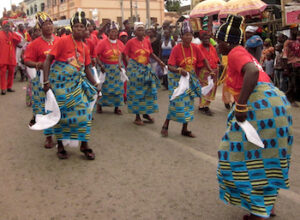
Fante African Community
*The Fante community is celebrated on this date in 1000. The Fante people combine the Akan and aboriginal Guan people, mainly located in the Central and Western Ghana forest and coastal areas.
Their land stretches from the eastern part of the western region in the west to Gomoa in the east. There are two groups of Fante: the Boka Fante and the Etsii Fante. According to their oral traditions, the Borbor Fante migrated from the Ahafo Region of Ghana and settled in Fanteland. They initially established themselves in Kwaman before moving to Mankessim, after which they established the states of Abora, Ekumfi, Enyanmaim, Mankessim, and Nkusukum. The burial ground near Mankessim is the most sacred place in the historic spiritual capital of Mankessim.
The Etsii Fante states, which include Eguafo, Fetu, and Asebu, are from west to east. The others are Oguaa, Elmina, Moree, Otsir, etc. Most of the people in these states do not have migration stories. According to their oral traditions, their ancestors descended from the heavens or emerged from the sea, rivers, or dense forests. Eguafo, known as Oman Panyin in Fanteland and the oldest state, was founded by people who descended from the heavens in a large brass pan called Ayewa Kese. The Asebu people claim that their ancestors emerged from the earth, while the Sonkwa believe their forefathers emerged from a nearby sacred grove.
The Fante people are of heterogeneous ancestry. That is, Guan and Akan. With the modern Fante Confederacy, it is wrong to identify Fante as Akan or Guan; the Fante is one of the largest groups in Ghana. When the Portuguese arrived in the 15th century, the Fante prevented them from venturing inland and leased properties for Portuguese trading missions. However, when the Portuguese objected to Fante's rules and regulations, Fante expelled them after several skirmishes and battles. After that, the Dutch arrived, followed by the British.
The Fante served as a middleman in slavery and other commerce between the interior and British and Dutch traders on the coast. The Fante became very wealthy and prosperous in dealings with the various European powers. Despite the rapid growth of the Ashanti Empire and constant war with the Ashanti and allied Dutch in the mid-1800s, the Fante have always retained their state to this day and fought numerous battles to protect their northern flank from Ashanti incursions and several other wars with the Dutch, and English.
They are about 4.5 million, about 13% of modern Ghana's total population. Inheritance and succession to public office among the Etsii and Borbor Fantes are traditionally determined by matrilineal descent, a culture the Etsii (Guan) Fantes adopted from Borbor (Akan) Fantes. However, Fante males of fighting age traditionally belonged to their father's company. Over the last half-century, Fante communities have been in the Gambia, Liberia, and even Angola due to fishing expeditions. Major Fante cities in modern Ghana include Cape Coast, Elmina, Agona Swedru, Komenda, Tarkwa, and Anomabo.